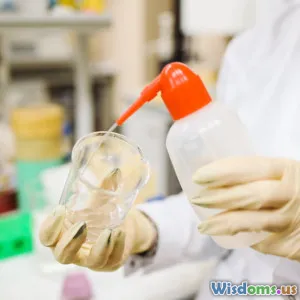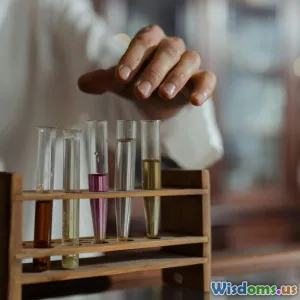
Answering Myths About Inorganic Chemistry and Its Dangers
11 min read Debunking common misconceptions about inorganic chemistry and its safety through facts and real-world insights. (0 Reviews)
Answering Myths About Inorganic Chemistry and Its Dangers
Introduction: Unveiling the Hidden Truths
Inorganic chemistry has long been a subject shrouded in mystery and misconception. For many, the term itself evokes images of hazardous substances, toxic fumes, and invisible dangers lurking in laboratories or industrial plants. Despite its fundamental role in science and daily life, inorganic chemistry is frequently misunderstood—not least because of myths that exaggerate its risks. But how accurate are these fears? Are inorganic compounds inherently dangerous, or is there a different reality beneath the surface?
This article aims to answer these questions by examining common myths about inorganic chemistry, exploring the science behind it, and shedding light on the genuine safety measures in place. By the end, the goal is for readers not only to understand inorganic chemistry better but to appreciate its significance and learn how danger is mitigated effectively.
What Is Inorganic Chemistry? Setting the Foundation
Simply put, inorganic chemistry concerns the study of compounds that do not primarily contain carbon-hydrogen (C–H) bonds, distinguishing it from organic chemistry. This field includes metals, minerals, salts, and gases—components central to everything from electronics to medicine.
Common Misconception: Inorganic Means Dangerous
Many people believe that because something is a chemical and inorganic, it must be toxic or hazardous. This, however, is not true. Ordinary table salt (sodium chloride) and water (often categorized under inorganic chemistry due to its structure) are harmless under normal conditions. The context and chemical nature significantly influence the hazards, not the classification itself.
Debunking Key Myths about Inorganic Chemistry and Its Risks
Myth 1: All Inorganic Compounds Are Toxic
In truth, toxicity varies dramatically depending on the specific compound, dose, and exposure method. For example:
- Water (H₂O): Crucial for life and a classic inorganic compound.
- Sodium chloride (NaCl): Common table salt, consumed daily.
- Silicon dioxide (SiO₂): An abundant mineral used in glass making.
By contrast, some organic substances (like cyanide-containing compounds) can be deadly, so being inorganic doesn’t imply automatic danger.
Myth 2: Handling Inorganic Chemicals Requires Extreme Precaution at All Times
While safety always matters in chemical handling, many inorganic substances are stable and safe with standard precautions. For instance, magnesium salts and many metal oxides are safely used in supplements and cosmetics globally.
Lab protocols, regulated by organizations such as OSHA (Occupational Safety and Health Administration) and EPA (Environmental Protection Agency), ensure that any potentially hazardous inorganic chemicals are handled with proper care. Innovations like closed system reactors and fume hoods have drastically reduced potential risks.
Myth 3: Exposure to Inorganic Chemicals Will Inevitably Cause Harm
Acute or chronic harm depends on factors such as concentration, duration, individual's health, and compound type. Trace amounts of many inorganic minerals are actually essential for human health (e.g., iron and zinc).
Moreover, industrial hygiene practices and environmental controls minimize exposure to harmful inorganic pollutants, making accidental harm far less common than imagined.
Real-World Applications Highlighting Inorganic Chemistry’s Value
Far beyond the lab, inorganic chemistry improves and shapes our world in numerous constructive ways, underscoring why its negative myths are so damaging.
Medicine and Healthcare
Many inorganic compounds enable modern medicine:
- Platinum-based drugs, like cisplatin, treat cancer by targeting tumor cells.
- Contrast agents containing gadolinium enhance MRI imaging.
- Calcium phosphate is used in bone grafts and dental products.
These examples illustrate that inorganic chemistry not only can be safe but also life-saving.
Technology and Industry
Industry relies on inorganic chemistry for advanced technologies:
- Semiconductors: Silicon, a fundamental inorganic semiconductor, allows smartphones and computers to function.
- Catalysts: Metal oxides and complexes increase efficiency in product manufacturing.
- Batteries: Lithium-ion and other energy storage technologies depend on inorganic materials.
Environment and Sustainability
Inorganic chemistry also plays a role in environmental solutions:
- Removing heavy metal pollutants through ion-exchange materials minimizes ecological damage.
- Photocatalysis utilizing titanium dioxide helps break down harmful pollutants.
These benefits manifest only when inorganic substances are well-understood and responsibly used.
The Science of Safety: How Do We Manage Risks?
Regulation and Standards
Multiple regulatory bodies enforce strict guidelines addressing the safe manufacture, usage, transport, and disposal of inorganic chemicals. Examples:
- REACH (Registration, Evaluation, Authorization, and Restriction of Chemicals) in the EU ensures compounds meet safety standards.
- TSCA (Toxic Substances Control Act) in the US governs the chemicals’ lifecycle to protect health and environment.
Laboratory and Workplace Safety Protocols
Chemists adhere to extensive safety training, personal protective equipment, ventilation controls, and spill response plans. Awareness, discipline, and technology combine to lower accident risks significantly.
Public Education and Transparency
Educational initiatives help demystify inorganic chemistry — teaching people which substances are harmless vs. toxic and promoting chemical literacy that informs safer decision-making.
Common Inorganic Chemicals: Understanding Risks and Benefits
| Compound | Use | Risk Level | Notes |
|---|---|---|---|
| Sodium chloride | Food seasoning | Very low | Safe in consumption, essential electrolyte |
| Ammonia | Cleaning agent | Moderate if inhaled | Proper ventilation reduces hazards |
| Lead compounds | Previously in paints | High | Phased out due to toxicity |
| Chromium VI | Industrial metal processing | High | Strict controls required |
This table underscores that risk varies widely — effective knowledge determines how safely inorganic chemicals can be integrated into life.
Conclusion: Beyond Myths—Embracing the Real World of Inorganic Chemistry
Inorganic chemistry is neither inherently dangerous nor mysterious terror; it is a vibrant field integral to medicine, technology, environment, and everyday products. Myths that paint it as universally hazardous overlook critical distinctions and advancements that render many inorganic compounds safe, valuable, and essential.
Understanding lies in recognizing context, dosage, properties, and rigorous safety practices. Educating ourselves about these factors moves society beyond misguided fears to an informed appreciation.
Embracing inorganic chemistry's true nature enables innovation without sacrificing safety—thereby enriching lives responsibly.
References and Further Reading
- National Institute of Health: Toxicological Profiles for Various Inorganic Chemicals
- EPA: Inorganic Chemical Safety Guidelines
- Clare B. Hunt, et al. (2015). Inorganic Chemistry and Environmental Safety. Wiley.
- OSHA: Chemical Safety and Hazard Awareness
Author's Note: This article aims to provide clarity on inorganic chemistry and encourage curiosity and respect for science, dismantling misinformation with knowledge.
Rate the Post
User Reviews
Other posts in Chemistry & Chemical Engineering
Popular Posts

















